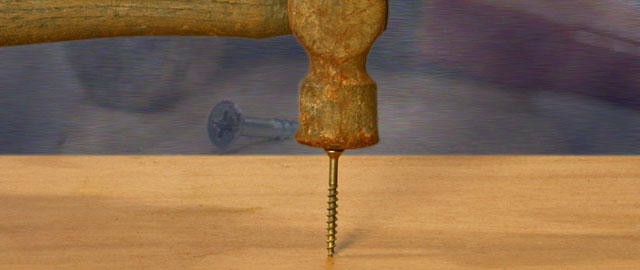… everything looks like a nail.”
I ran into a colleague earlier today. While we were sharing war stories, he brought up a time that he was working at a defense contractor. He was working with IT to solve an issue where they were trying to get a particular piece of data out of a legacy system and have it appear in a widget on a dashboard. Nothing they were doing was working.
My friend said, “If I walk past the fountain outside and into any of the other buildings on your campus, they are full of people who can strap a payload to a metal can, propel it miles through the air by having it ride on an explosion, and drop that payload within an 18-inch circle. What’d’ya say we go ask one of them how they would solve this.”
“That won’t work. This is an IT problem,” they said.
“Actually, the problem is getting that piece of data out of that old system and getting it to show up in the new system,” my friend replied. He walked past the fountain in spite of their suggestions. One of the engineers was a friend of his, so he asked his friend how he would approach the problem. His friend put down his sandwich, wiped his hands on the front of his shirt, and scrawled a solution on a scrap piece of paper. And the solution worked.
All too often, people mistake the solution for the problem. IT sees everything as a technology problem – mostly because that’s what they have closest at hand to solve the problem. Conversely, business users will opt for enacting a new policy or change management process when technology can ameliorate an existing process that is overly complex. We all grab the handiest tool and attack the problem as if that problem just needs a few whacks with our hammer.
“And if you’re bothered by a loose nail, everything looks like a hammer”
– Devin Henkel
The issue I had while working in innovation was the converse. We would run challenges to crowdsource solutions to certain issues. Given that are firm is fairly large, it’s no surprise that we would end up with a large bucket of ideas. The problem is that many of the ideas could not be enacted in their current form. The metaphor I liked to use (that got me into trouble with my colleagues) was that not every idea was a kernel of corn that passed through the digestive tract and came out looking pretty much the same as it went in. Colorful? Yes. But, it got my point across.
So, my solution was to create a collaborative workshop. A digestive tract for ideas… There was still some nutritional content to be extracted from those ideas. The goal was to take that bucket of ideas and turn it into 3-5 actionable initiatives that could be enacted with strategic traceability. The problem was that we would get 40 people in the room, and they would view all the ideas within the context of the problems they were facing. They would grab an idea and test its heft to see if it could pound the loose nail they were seeing on the client site each day. While a stapler may be heavy enough to drive a nail, that’s not the best thing it does.
So, my approach was to reframe the problem as someone else’s problem. What if Disney was having this problem? How would they solve it? What if Starbucks was trying to accomplish X? How would these ideas help them achieve that goal? This allowed participants to get their head out of the client site and a) see the problem in a new light, and b) see the value inherent in the solutions that wasn’t derived from their own agenda.
By reframing the problem and re-casting the tools, we can ferret out the optimal usage for a tool and propose the optimal solutions to an issue.



